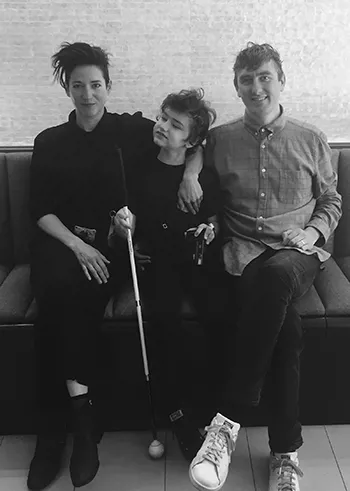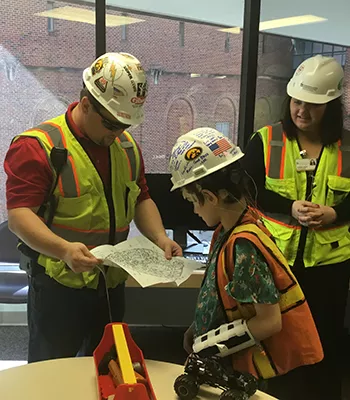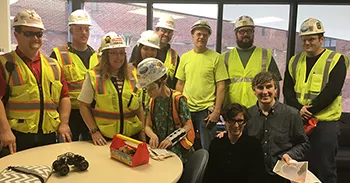Looking back, moving forward

New York family discovers UI expertise—and ‘Iowa nice’—in the care for their son
For years, Myat Haggart’s parents have been searching for answers.
Myat, a 10-year-old living in New York City, has been blind since age 5. He also wears bilateral hearing aids to help with hearing loss and has other health issues.
In fall 2015, after testing showed Myat had a rare genetic mutation, his mother, Kara Bohnenstiel, learned something extraordinary. An Internet search revealed that researchers at the University of Iowa had been studying the same mutation in their lab. They had also treated other patients with an eye disease similar to Myat’s.
Kara immediately e-mailed one of the doctors who had authored the study. In less than 48 hours, she and her husband, Scott Haggart, were on the phone with the doctor and one of his colleagues. Alex Bassuk, MD, PhD, a pediatric neurologist at University of Iowa Stead Family Children’s Hospital, and Vinit Mahajan, MD, PhD, an ophthalmologist at University of Iowa Hospitals & Clinics, spent two hours one Sunday afternoon learning about Myat and talking about their research.
“Obviously they are trying to learn more about the science [behind this], but they are kind-hearted people too,” Kara says.
Kara and Scott were excited about the prospect of bringing their son to UI Stead Family Children’s Hospital—so excited that they switched insurance providers so Myat could receive care in Iowa City. During a school break in February, they came to UI Stead Family Children’s Hospital for appointments and a short hospital stay. Their experience exceeded expectations−from a medical standpoint and an emotional one.
“He had so many amazing, positive experiences,” explains Kara.
Treating Myat’s condition
While at UI Stead Family Children’s Hospital, Myat underwent a series of tests.
“We are trying to think of him holistically,” says Bassuk. “We were trying to look for inflammation in other parts of his body.”
The team believes that inflammation is responsible for Myat’s hearing loss and other conditions. Indeed, their research indicates that Myat’s mutation could cause problems throughout a person’s body. So far, though, other patients with the mutation have shown only symptoms of eye disease.
Pediatric rheumatologist Polly Ferguson, MD, also met with Myat and his parents.
“The biggest thing for me is to save his hearing,” says Ferguson.
Based on their research and an examination of Myat, the doctors started him on anti-inflammatory therapies. It’s too early to tell what effect the treatment will have, but everyone is cautiously optimistic.
“I am so excited about the new treatment protocol developed at the University of Iowa,” Kara says.
And if Myat responds well, the doctors will have strong evidence that his conditions have been caused by inflammation throughout his body, according to Ferguson.
While Myat was in Iowa City, Bassuk also arranged for a consultation with Eyad Hanna, MD, a pediatric gastroenterologist. During the family’s stay at UI Stead Family Children’s Hospital, Bassuk helped to coordinate Myat’s care. He ushered the family throughout the hospital and discussed Myat’s symptoms with other members of the care team. The family had never experienced coordinated care before. As Iowa’s only comprehensive children’s hospital, UI Stead Family Children’s Hospital brings together every pediatric specialty under one roof. Rather than an individual doctor caring for Myat, teams of pediatric experts worked together to consider how all of his conditions might be related, allowing Myat to receive the best possible care.
To Myat’s mother, UI Stead Family Children’s Hospital is a “joyous, hopeful place.”
“Everything is so fast in New York City,” Kara says. “At UI Stead Family Children’s Hospital, everyone took the time and created a much more relaxed child.”
Even small things, such as applying a numbing cream before an IV to reduce Myat’s pain, made a big difference. Kara was impressed with the hospital’s commitment to family-centered care, too.
“I’m not a scientist,” she says, “but everyone listened to me. They know that we know our child best.”
A treat for Myat

The care team also took the time to learn that Myat is passionate about construction. Myat told everyone he met about Lego® bricks, buildings, and construction equipment. At one point, he needed to wear gloves to protect an IV line. Child life specialist Kathy Duethman helped him imagine that he was wearing safety gloves like construction workers do. His gown then became a construction worker’s safety vest. Having the attention and care of child life specialists was an unexpected bonus, according to Kara. Although they had sought treatment from New York City to California to Scotland, the family had never met child life specialists until they came to Iowa.
When Myat discovered a toolbox in a playroom, he carried it everywhere and even was allowed to keep it in his room. During his free time, Myat worked with child life specialist Lisa Miguel. She placed holes in toilet paper tubes so Myat could insert a play drill through the holes. One day, she helped Myat construct an elaborate building out of cardboard, toilet paper tubes, and other supplies.
“He let me be his assistant,” Miguel says. “He created this whole masterpiece that was very well thought out.”
Myat explained where the pipes and windows were, for example. At home, Myat constantly builds things out of Lego bricks and scraps of wood.
“She made that [the process of building] happen in the hospital,” Kara says.
Once Duethman and Miguel got to know Myat, they told him about the new children’s hospital being built nearby. Soon Miguel had an idea.
“I thought, ‘Boy, he has to meet some of our construction crew, and they need to meet him,’” she says.

Without disclosing what she had in mind, she asked Myat’s parents if they would welcome visitors. Kara and Scott instantly said yes. Kara says that by this point, she had complete faith in the hospital’s employees.
One afternoon, there was a knock at the door to Myat’s room. What happened next was “the crescendo” of the family’s visit, says Kara. Five construction workers walked in. Kara was delighted that two of them were female. “There are hard-working women [in construction] too,” she told her son. The workers brought gifts for Myat: a T-shirt, a hard hat they had signed, and a rubber ducky wearing a hard hat. They also brought a blueprint showing where they had included his name written on ductwork in the new children’s hospital.
“It was really an overwhelming, emotional thing,” says Kara. “It meant a lot to me and Scott, and it meant a lot to Myat.”
She marvels that people took time out of their day to make Myat’s day special.
“There was no insurance being charged. There wasn’t a diagnosis line. There was nothing to be gained except for being really, really nice,” she says.
As the workers chatted with Myat, Miguel left the room to retrieve the project she had worked on earlier with Myat. The crew then listened intently as Myat explained his building.
A strong foundation
When Myat was discharged, the family had a long drive back to New York City. Myat was so attached to his hard hat that he insisted on wearing it all the time, even though it made him hot and sweaty. When he fell asleep, his parents tried to take it off—to no avail.
Myat and his family are back home. He’s still enchanted by his hard hat, and his parents marvel at their experiences at UI Stead Family Children’s Hospital. Kara is working with Myat’s care team in Iowa to find providers who will collaborate with them in New York City. She is thrilled at the work being done by physician scientists in Iowa.
“They’re just really doing hard-core science out in Iowa City,” she says, adding that everyone the family met was pleasant and positive. “The Midwestern archetype of everyone being so friendly really exists,” she says.
Kindness and knowledge. If Myat and his family were building a children’s hospital, those traits would form the foundation.